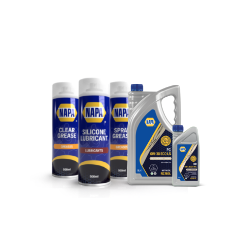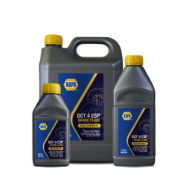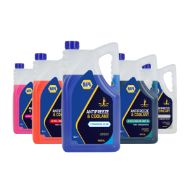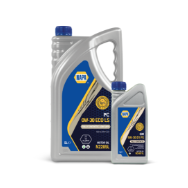Select your vehicle
Car Selector
Quick Pick
Know the part number? Enter it below with the required quantity:
Lubricants & Fluids

Shop automotive oil, lubricants, grease, and other fluids online
Automotive oils have some of the most essential tasks within a vehicle’s system, so it’s important that they’re doing their job correctly. Lubricants reduce friction between moving parts, hydraulics transmit power from one part to another, and coolants maintain temperatures. When these fluids leak, run low, or get contaminated, it can lead to much bigger problems.
NAPA Auto Parts is your one-stop solution for lubricants and fluids online. Search the make, model, and/or reg of your car using our VRM Look Up to discover the right oils for your vehicle.
With next-day delivery*, NAPA Auto Parts is committed to getting you back on the road as soon as possible.
What are the different types of fluid in a vehicle? What do they do?
There are six essential fluids that keep your car running efficiently.
1. Engine oil. Engine oil has three key functions. It coats important moving parts of the engine to keep them lubricated and reduce friction, it collects debris in the engine system, and it keeps the parts cool while in use.
Though it darkens over time, engine oil should be yellow or orange in colour with the consistency of olive oil. It has either no smell or a faint gasoline smell.
2. Gearbox oil or transmission fluid. Gearbox oil, also called transmission fluid, lubricates the transmission system to prevent the gears from grinding.
Automatic transmission fluid has a thin consistency and is typically clear with a brightly coloured hue. The most common colour is red, but it can vary. The fluid may be odourless or smell slightly sweet. Meanwhile, manual transmission fluid is a dark amber or brown, with a thicker consistency and a stronger smell.
3. Brake fluid and clutch fluid. Brake fluid (also used in the clutch) is a hydraulic oil. Hydraulic fluids are non-compressible liquids that take force from one part of the vehicle (ie. the brake pedal) and apply it to another (ie. the wheels).
Brake fluid is a slippery yellow liquid that smells like fish oil.
4. Power steering fluid and suspension fluid. Power steering fluid is a hydraulic fluid that connects the steering wheel to the front wheels, decreasing the effort required to turn the wheels. Suspension fluid absorbs bumps and vibrations on the road for a smoother ride in hydraulic suspension systems.
Power steering fluid is relatively clear with red, pink, or amber hues and a burnt marshmallow smell.
5. Coolant or antifreeze. Coolant is simply antifreeze diluted with water. It maintains the temperature of your engine during extreme hot or cold weather. In vehicles with air conditioning, AC coolant pulls heat from the air, creating the cooler air that is sent through the vehicle.
Coolant is a sweet-smelling, clear, and brightly coloured liquid, though the specific colour varies.
6. Windscreen washer fluid or screenwash. Windscreen washer fluid, or screen wash, is a fluid that cleans the vehicle’s windscreen with the windscreen wipers. It’s a legal offence to drive without washer fluid in the UK.
Windscreen washer fluid is a watery and brightly coloured liquid. Blue is the most common colour, but many alternatives are available.
Grease is an additional important lubricant for your vehicle. Used in areas that oils and fluids can’t easily be applied, grease is a thicker semi-solid lubricant that provides heavy-duty resistance to water and corrosion.
What are the most common signs of low, contaminated, or leaking fluids?
Over time, the fluids keeping your vehicle running can break down, run low, become contaminated with debris, or even leak. They should be inspected with regular servicing so they can be topped up or replaced when needed. It’s important to know what to look for before more serious and expensive damage occurs.
Here are the most common signs of problems with your vehicle’s lubricants and fluids:
Universal signs.
- The fluid is discoloured and thicker. If the fluid is black or dark brown with a thicker consistency like sludge, mud, jelly, or tar, this means the fluid is contaminated and needs to be replaced.
- Puddle of liquid under your car. If there’s dark or coloured fluid pooling under your car, your vehicle most likely has a leak. The colour, consistency, and location of the fluid can inform you which fluid is leaking.
- Warning lights on your dashboard. While this can indicate other problems within the relevant systems, it can also inform you of low or polluted fluids.
Bad engine oil.
- Rumbling or knocking noises in engine. This indicates the parts aren’t sufficiently lubricated.
- Oil smell inside the car. This can indicate an engine oil leak.
- Gas or exhaust smell inside the car. This is a sign your engine is overheating.
- Smoke coming from the exhaust. A number of oil, fuel, and coolant problems can cause this. Check your engine oil first.
Bad gearbox oil or transmission fluid.
- Whining or humming noises. This can indicate insufficient lubrication.
- Grinding when changing gears. This could be low fluid or damaged components.
- The vehicle vibrating, lurching, and slipping. This could be a few transmission problems, including low or contaminated fluid.
- Stuck clutch. Low transmission fluid can affect the clutch performance.
- Delayed response when changing gears. This is a clear sign of low transmission fluid.
Bad brake fluid.
- Grinding or squeaking brakes. Noises when braking can have a few causes, including insufficient brake fluid.
- Unresponsive or spongy brake pedal. This should be inspected immediately.
- Vibration when braking. This can be caused by worn brake pads or low brake fluid.
- Vehicle pulling to the side when braking. This could indicate your brake fluid is contaminated.
Bad power steering and suspension fluid.
- Whining, grinding, or screeching noises when steering. This is a sign that the power steering pump is working harder than it needs to, most often caused by low or contaminated fluid.
- Stiff or loose steering. This can indicate insufficient fluid levels in your steering system.
- Greasy shock absorbers. This is likely the result of a suspension fluid leak.
- Foamy liquid under car. When steering and suspension fluid is leaking, it can become foamy. This is an easy way to identify a leak.
- Burnt or charred smell. This is a good sign your steering fluid needs to be replaced.
Bad coolant.
- Sweet smell in car while driving. This is a sign of a coolant leak.
- Engine overheating. This is a clear indication that the coolant isn’t performing correctly.
- Trouble starting in winter. If your engine won’t start in cold weather, it might be as simple as changing the coolant. It’s best to start with this before more expensive alternatives.
- Rusty or speckled fluid. If your coolant looks like it has specks of rust in it, you’ll need to flush the coolant system.
- Boiling or bubbling coolant. This is likely caused by another component in the system, like the head gasket, but coolant should be flushed and replaced once the system is fixed.
The lubricants and fluids in your vehicle are critical to your safety on the road. While some of these problems may seem small on their own, not addressing them early can lead to more expensive damage of bigger components — and even total system failure.
This is why it’s vital that your car is serviced by a mechanic as soon as possible when experiencing these warning signs. NAPA Auto Parts makes all efforts to deliver your lubricants and fluids as fast as possible to get your vehicle back on the road.
How often should your car’s lubricants and fluids be replaced?
Lubricants and fluids are some of the most frequently changed part of any vehicle, though exactly how often oil changes are needed depends on the age and condition of the vehicle along with the type of fluid.
Topping up fluids can also prolong the period between full flushes, but be mindful of the condition of the pre-existing fluid before doing so.
As a broad guideline, this is how often your fluids should be replaced:
- Engine oil should be changed every 5,000 to 7,000 miles (or 6 months).
- Gearbox oil or transmission fluid should be changed every 30,000 to 60,000 miles (or 2 years).
- Brake fluid should be changed every 30,000 miles (or 2 years).
- Power steering fluid should be changed every 30,000 to 80,000 miles (or 2 years).
- Coolant should be changed every 30,000 miles (or 2 years).
- Greased components should be inspected at every oil change so grease can be reapplied as needed.
Always check the advice provided by the relevant manufacturer and ensure your vehicle is serviced regularly.
What oil or fluid does my vehicle need?
When shopping for oils and lubricants, you’ll find terms like “5W30 fully synthetic oil” — but what does this mean?
This numbering system is the oil grade, which represents the viscosity of the fluid and informs you of its performance in different temperatures. A fluid with a low viscosity grade will have a thinner consistency and flow more easily, while a high viscosity grade fluid will be thicker.
Monograde fluids, which have a single number, are used in some older vehicles with a smaller temperature range. Modern vehicles use multigrade fluids, which have two numbers.
The number before the W — which means “winter” — indicates the performance at low temperatures. The lower the number, the easier it is for the lubricated parts to operate when cold.
The number after the W indicates the performance at high temperatures. The higher the number, the more the components are protected against overheating.
For example, a 75W90 gear oil will rely on the warmth from the engine to get started in cold weather, but it provides high heat and corrosion protection.
The handbook provided by your vehicle manufacturer will specify the grades of oil that are best suited for your car. Alternatively, you can search NAPA’s Oil Finder by make, model, or reg to find the right NAPA-branded product for you.
How much does it cost to replace lubricants and fluids?
The price of changing your car’s oils, fluids, and lubricants can vary depending on which fluid need to be changed and which version your vehicle needs. Fortunately, an oil or fluid change is one of the cheapest replacements available for a vehicle. That’s why it’s beneficial to flush and replace the fluids regularly before bigger parts are damaged as a result of insufficient lubrication.
Whichever fluid your car needs, NAPA Auto Parts is committed to bringing you great quality at affordable prices.
Save on a vast catalogue of engine oils, brake fluids, coolant fluids, grease, and more with NAPA Auto Parts UK.
*Limitations apply.





